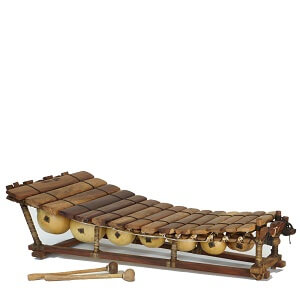Balafon
 The Mandinka balafon, also called the bala or the balphone, is a kind of idiophone (an instrument which creates sound by vibrating). In the West, instruments like this are called xylophones. The balafon is associated with the Griot, an hereditary musicianship tradition of West Africa and in The Gambia this tends to be mostly found in Brikama (where there are also a lot of griot or ‘jeli’ families who play the kora or African harp).
The Mandinka balafon, also called the bala or the balphone, is a kind of idiophone (an instrument which creates sound by vibrating). In the West, instruments like this are called xylophones. The balafon is associated with the Griot, an hereditary musicianship tradition of West Africa and in The Gambia this tends to be mostly found in Brikama (where there are also a lot of griot or ‘jeli’ families who play the kora or African harp).
This beautiful instrument has a history tied up with the stories and legends of the formation of the Mandinka Empire, a story similar to the Arthurian legends of the West. A story of a king, Sunjata Keita, who united the warring tribes by prowess and magic, and created an era of peace and prosperity, sometime in the 13th or 14th centuries. Stories of Sunjata from Gambian sources can be found in many places but Bamba Suso and Banna Kanutes’ book Sunjata, published by Penguin Classics, is a great place to start for those who are interested. Separating truth from fiction here is hard and there are many, many stories and songs of these legends, but somewhere along the line the Mandinka Kingdom was formed. The Griots, or Jelis as they are more commonly called in The Gambia, were the praise singers and court musicians of the Mandinka Empire. Stories of the first balafon, given by a spirit to Sunjata, and the first balafon, player seem to date from this time. One version of the story of ‘bala konte’ (or Kante, spelling is hard to pin down here and tends to depend on whether sources are English or French in origin) has him losing his name, to be given the name of his instrument instead. His own identity eclipsed by his importance as the player of the balafon. He was hamstrung too, according to stories I’ve been told, so he could go nowhere and do nothing but play the balafon in the court of the king.
The Jelis, or hereditary musicians, pass down the teaching of an instrument, generally from father to son but occasionally to a daughter as women are not forbidden to play. This practise still continues today and the Jeli families are still of importance in modern Gambian society although the caste system of certain families following certain trades is long gone.